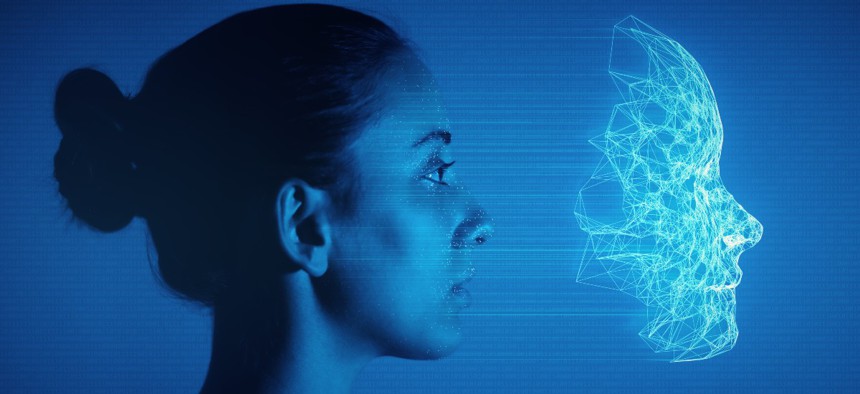Debunking Myths Around Facial Recognition: What Government Agencies Need to Know

imaginima/Getty Images
Government use of facial recognition technology provides its fair share of controversy, as well as tangible benefits.
In spite of the recent controversy surrounding facial recognition, it’s important to recognize that the technology has real, tangible benefits in the government sector. Consider examples like the U.S. Customs and Border Protection service which, along with airport officials, matches passport photos to a database to verify the identity of thousands of travelers entering and leaving the U.S. each week. This system has intercepted hundreds of people attempting to enter the U.S. under a fraudulent identity, helping combat related crimes like human trafficking and drug smuggling.
Additionally, consider the system in place at many U.S. airports that is designed to eliminate the need for a boarding pass at the gate. Facial comparison of the traveler’s face to that of his or her passport scanned at the time of check-in—or on file—provides an efficient and safe boarding experience.
It is important that government agencies do not waver from their use of this key authentication process because it brings much needed value to our nation’s safety and security. By debunking the myths around facial recognition, we can counteract negative claims and increase comfort levels—for both government agencies and citizens.
“It’s too risky”
People tend to have this vision of a big, master database of facial data, prime for hacking and misuse. It is true that data breaches continue to rise in volume and severity around the globe, and it is understandable that citizens would have concerns. However, new, innovative approaches are evolving all the time to help mitigate this vulnerability. One example is the concept of decentralized biometrics, which entails storing data throughout a vast peer-to-peer network in the form of data fragments, making it virtually impossible for a hacker to access full facial datasets for nefarious purposes.
“It promotes bias”
Today’s facial matching algorithms are “trained” on the most diverse data sets in the world and have been proven to be able to distinguish between individuals within minority groups or ethnicities with a greater than 99 percent accuracy rate. Facial recognition technologies are so accurate that, rather than being a source of bias, a far more common scenario is facial recognition capabilities helping overcome bias at the human level—being used to supplement eyewitness identifications in criminal investigations which are notoriously prone to error.
It is also very important to note that face-based authentication, in most scenarios, is a 1:1 compare process. The person’s live face is compared to the face presented at the time of enrollment for access to a system or a service. It either matches the face on record or it does not. There is no bias. Regardless of how accurate these solutions are, we always emphasize that humans should be involved in determining whether or not a set of faces is or isn’t a match.
“It’s too intrusive”
Some people may feel this way, but in reality, the government has collected our most personal details and handled our most sensitive data every day, for years. Think of the extensive documentation and data you provide as part of the passport issuance process. Or the social security administration, which has access to all of our social security numbers; or various state departments of transportation, which house large facial image databases through their registries of motor vehicles. A faceprint is not much different. As noted above, government agencies consistently deploy the most cutting-edge security technologies to protect this data.
Commercially speaking, we advocate for all applications of facial recognition to require clear opt-in and opt-out guidelines, so people know exactly what personal data is being collected, when and how it will be used. We also believe, however, there is one exception where the consent-based approach should not be binding—and that is specific government use cases like homeland security, law enforcement and others highly prone to malicious fraud or criminal activity. U.S. agencies have had some great successes with facial recognition, and we believe few would question the integrity or permissibility of these.
Note that the official FBI guidelines for one to many (1:N) facial searches specify that only the human expert examiner has the final adjudication determining if one face is likely the same as another face. That decision is used only to warrant further possible investigatory work. Government-sponsored expert working groups such as OSAC Facial Identification Subcommittee and Facial Identification Scientific Working Group have defined specific protocols and guidelines for the training of facial examiners.
We encourage government agencies and the public to not lose sight of the real benefits facial recognition brings. We’re confident they won’t: even though facial recognition is a hot topic and somewhat controversial, recent surveys show that a broad range of government agencies are actually poised to increase their use of facial recognition in the near future, while many others are investing in research and development for the technology. With the right guardrails in place, it is possible to experience all the benefits of facial recognition while maintaining an emphasis on “privacy first.”
Robert M. Mungovan has over 20 years of experience with Aware. Prior to his current role as chief commercial officer, Mungovan served as Aware’s vice president of biometrics and as the sales and marketing manager of biometrics and imaging. Before joining Aware Mungovan held positions in several small companies whose focus was digital imaging and machine vision.
NEXT STORY: Transformation and the CX executive order





